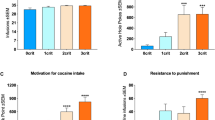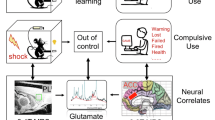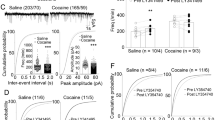Abstract
Medication development for cocaine-addicted patients is difficult, and many promising preclinical candidates have failed in clinical trials. One reason for the difficulty in translating preclinical findings to the human condition is that drug testing is typically conducted in behavioral procedures in which animals do not show addiction-like traits. Recently, a DSM-IV-based animal model has been developed that allows studying the transition to an addiction-like behavior. Changes in synaptic plasticity are involved in the transition to cocaine addiction. In particular, it has been shown that metabotropic glutamate receptor 2/3 (mGluR2/3)-mediated long-term depression is suppressed in the prelimbic cortex in addict-like rats. We therefore hypothesized that cocaine-seeking in addict-like rats could be treated with an mGluR2/3 agonist. Indeed, addict-like rats that were treated systemically with the mGluR2/3 agonist LY379268 (0, 0.3, and 3 mg/kg) showed a pronounced reduction in cue-induced reinstatement of cocaine-seeking. In an attempt to dissect the role played by mGluR2 and mGluR3 in cue-induced reinstatement, we analyzed the mRNA expression patterns in several relevant brain areas but did not find any significant differences between cocaine addict-like and non-addict-like rats, suggesting that the behavioral differences observed are due to translational rather than transcriptional regulation. Another possibility to study the contributions of mGluR2 and mGluR3 in mediating addictive-like behavior is the use of knockout models. Because mGluR2 knockouts cannot be used in operant procedures due to motoric impairment, we only tested mGluR3 knockouts. These mice did not differ from controls in reinstatement, suggesting that mGluR2 receptors are critical in mediating addictive-like behavior.
Similar content being viewed by others
Log in or create a free account to read this content
Gain free access to this article, as well as selected content from this journal and more on nature.com
or
References
Ahmed SH, Koob GF (1998). Transition from moderate to excessive drug intake: change in hedonic set point. Science 282: 298–300.
Aujla H, Martin-Fardon R, Weiss F (2008). Rats with extended access to cocaine exhibit increased stress reactivity and sensitivity to the anxiolytic-like effects of the mGluR 2/3 agonist LY379268 during abstinence. Neuropsychopharmacology 33: 1818–1826.
Baker DA, McFarland K, Lake RW, Shen H, Tang XC, Toda S et al (2003). Neuroadaptations in cystine-glutamate exchange underlie cocaine relapse. Nat Neurosci 6: 743–749.
Baptista MA, Martin-Fardon R, Weiss F (2004). Preferential effects of the metabotropic glutamate 2/3 receptor agonist LY379268 on conditioned reinstatement versus primary reinforcement: comparison between cocaine and a potent conventional reinforcer. J Neurosci 24: 4723–4727.
Belin D, Balado E, Piazza PV, Deroche-Gamonet V (2009). Pattern of intake and drug craving predict the development of cocaine addiction-like behavior in rats. Biol Psychiatry 65: 863–868.
Belin D, Mar AC, Dalley JW, Robbins TW, Everitt BJ (2008). High impulsivity predicts the switch to compulsive cocaine-taking. Science 320: 1352–1355.
Bossert JM, Busch RF, Gray SM (2005). The novel mGluR2/3 agonist LY379268 attenuates cue-induced reinstatement of heroin seeking. Neuroreport 16: 1013–1016.
Bossert JM, Gray SM, Lu L, Shaham Y (2006a). Activation of group II metabotropic glutamate receptors in the nucleus accumbens shell attenuates context-induced relapse to heroin seeking. Neuropsychopharmacology 31: 2197–2209.
Bossert JM, Liu SY, Lu L, Shaham Y (2004). A role of ventral tegmental area glutamate in contextual cue-induced relapse to heroin seeking. J Neurosci 24: 10726–10730.
Bossert JM, Poles GC, Sheffler-Collins SI, Ghitza UE (2006b). The mGluR2/3 agonist LY379268 attenuates context- and discrete cue-induced reinstatement of sucrose seeking but not sucrose self-administration in rats. Behav Brain Res 173: 148–152.
Corti C, Battaglia G, Molinaro G, Riozzi B, Pittaluga A, Corsi M et al (2007). The use of knock-out mice unravels distinct roles for mGlu2 and mGlu3 metabotropic glutamate receptors in mechanisms of neurodegeneration/neuroprotection. J Neurosci 27: 8297–8308.
D'Souza MS, Liechti ME, Ramirez-Nino AM, Kuczenski R, Markou A (2011). The metabotropic glutamate 2/3 receptor agonist LY379268 blocked nicotine-induced increases in nucleus accumbens shell dopamine only in the presence of a nicotine-associated context in rats. Neuropsychopharmacology 36: 2111–2124.
Deroche-Gamonet V, Belin D, Piazza PV (2004). Evidence for addiction-like behavior in the rat. Science 305: 1014–1017.
Hansson AC, Sommer W, Rimondini R, Andbjer B, Stromberg I, Fuxe K (2003). c-fos reduces corticosterone-mediated effects on neurotrophic factor expression in the rat hippocampal CA1 region. J Neurosci 23: 6013–6022.
Hao Y, Martin-Fardon R, Weiss F (2010). Behavioral and functional evidence of metabotropic glutamate receptor 2/3 and metabotropic glutamate receptor 5 dysregulation in cocaine-escalated rats: factor in the transition to dependence. Biol Psychiatry 68: 240–248.
Jin X, Semenova S, Yang L, Ardecky R, Sheffler DJ, Dahl R et al (2010). The mGluR2 positive allosteric modulator BINA decreases cocaine self-administration and cue-induced cocaine-seeking and counteracts cocaine-induced enhancement of brain reward function in rats. Neuropsychopharmacology 35: 2021–2036.
Kalivas PW (2009). The glutamate homeostasis hypothesis of addiction. Nat Rev Neurosci 10: 561–572.
Kalivas PW, Volkow ND (2005). The neural basis of addiction: a pathology of motivation and choice. Am J Psychiatry 162: 1403–1413.
Kasanetz F, Deroche-Gamonet V, Berson N, Balado E, Lafourcade M, Manzoni O et al (2010). Transition to addiction is associated with a persistent impairment in synaptic plasticity. Science 328: 1709–1712.
Kasanetz F, Lafourcade M, Deroche-Gamonet V, Revest JM, Berson N, Balado E et al (2012). Prefrontal synaptic markers of cocaine addiction-like behavior in rats. Mol Psychiatry doi:10.1038/mp.2012.59 (e-pub ahead of print).
Koob GF, Volkow ND (2010). Neurocircuitry of addiction. Neuropsychopharmacology 35: 217–238.
Kufahl PR, Martin-Fardon R, Weiss F (2011). Enhanced sensitivity to attenuation of conditioned reinstatement by the mGluR 2/3 agonist LY379268 and increased functional activity of mGluR 2/3 in rats with a history of ethanol dependence. Neuropsychopharmacology 36: 2762–2773.
Kufahl PR, Watterson LR, Nemirovsky NE, Hood LE, Villa A, Halstengard C et al (2013). Attenuation of methamphetamine seeking by the mGluR2/3 agonist LY379268 in rats with histories of restricted and escalated self-administration. Neuropharmacology 66: 290–301.
Lenoir M, Guillem K, Koob GF, Ahmed SH (2012). Drug specificity in extended access cocaine and heroin self-administration. Addict Biol 17: 964–976.
Liechti ME, Lhuillier L, Kaupmann K, Markou A (2007). Metabotropic glutamate 2/3 receptors in the ventral tegmental area and the nucleus accumbens shell are involved in behaviors relating to nicotine dependence. J Neurosci 27: 9077–9085.
Lu L, Uejima JL, Gray SM, Bossert JM, Shaham Y (2007). Systemic and central amygdala injections of the mGluR(2/3) agonist LY379268 attenuate the expression of incubation of cocaine craving. Biol Psychiatry 61: 591–598.
Lu L, Xue Y, Steketee JD, Rebec GV, Sun W (2012). Regulation of cocaine-induced reinstatement by group II metabotropic glutamate receptors in the ventral tegmental area. Psychopharmacology (Berl) 220: 75–85.
Martin-Fardon R, Weiss F (2012). (-)-2-oxa-4-aminobicylco[3.1.0]hexane-4,6-dicarboxylic acid (LY379268) and 3-[(2-methyl-1,3-thiazol-4-yl)ethynyl]piperidine (MTEP) similarly attenuate stress-induced reinstatement of cocaine seeking. Addict Biol 17: 557–564.
Meinhardt MW, Hansson AC, Perreau-Lenz S, Bauder-Wenz C, Stahlin O, Heilig M et al (2013). Rescue of infralimbic mGluR2 deficit restores control over drug-seeking behavior in alcohol dependence. J Neurosci 33: 2794–2806.
Morishima Y, Miyakawa T, Furuyashiki T, Tanaka Y, Mizuma H, Nakanishi S (2005). Enhanced cocaine responsiveness and impaired motor coordination in metabotropic glutamate receptor subtype 2 knockout mice. Proc Natl Acad Sci USA 102: 4170–4175.
Moussawi K, Zhou W, Shen H, Reichel CM, See RE, Carr DB et al (2011). Reversing cocaine-induced synaptic potentiation provides enduring protection from relapse. Proc Natl Acad Sci USA 108: 385–390.
Noori HR, Spanagel R, Hansson AC (2012). Neurocircuitry for modeling drug effects. Addict Biol 17: 827–864.
Ohishi H, Shigemoto R, Nakanishi S, Mizuno N (1993). Distribution of the messenger RNA for a metabotropic glutamate receptor, mGluR2, in the central nervous system of the rat. Neuroscience 53: 1009–1018.
Pelloux Y, Everitt BJ, Dickinson A (2007). Compulsive drug seeking by rats under punishment: effects of drug taking history. Psychopharmacology (Berl) 194: 127–137.
Peters J, Kalivas PW (2006). The group II metabotropic glutamate receptor agonist, LY379268, inhibits both cocaine- and food-seeking behavior in rats. Psychopharmacology (Berl) 186: 143–149.
Sanchis-Segura C, Spanagel R (2006). Behavioural assessment of drug reinforcement and addictive features in rodents: an overview. Addict Biol 11: 2–38.
Sidhpura N, Weiss F, Martin-Fardon R (2010). Effects of the mGlu2/3 agonist LY379268 and the mGlu5 antagonist MTEP on ethanol seeking and reinforcement are differentially altered in rats with a history of ethanol dependence. Biol Psychiatry 67: 804–811.
Tanabe Y, Nomura A, Masu M, Shigemoto R, Mizuno N, Nakanishi S (1993). Signal transduction, pharmacological properties, and expression patterns of two rat metabotropic glutamate receptors, mGluR3 and mGluR4. J Neurosci 13: 1372–1378.
Uejima JL, Bossert JM, Poles GC, Lu L (2007). Systemic and central amygdala injections of the mGluR2/3 agonist LY379268 attenuate the expression of incubation of sucrose craving in rats. Behav Brain Res 181: 292–296.
Wikler A, Pescor FT (1967). Classical conditioning of a morphine abstinence phenomenon, reinforcement of opioid-drinking behavior and ‘relapse’ in morphine-addicted rats. Psychopharmacologia 10: 255–284.
Wolffgramm J, Heyne A (1995). From controlled drug intake to loss of control: the irreversible development of drug addiction in the rat. Behav Brain Res 70: 77–94.
Zhao Y, Dayas CV, Aujla H, Baptista MA, Martin-Fardon R, Weiss F (2006). Activation of group II metabotropic glutamate receptors attenuates both stress and cue-induced ethanol-seeking and modulates c-fos expression in the hippocampus and amygdala. J Neurosci 26: 9967–9974.
Acknowledgements
We would like to thank Dr Rick Bernardi for assisting with English editing. A special acknowledgement goes to Jean-Francois Fiancette, Prisca Renault, and Eric Balado for training NC. in Bordeaux. This work was supported by the Deutsche Forschungsgemeinschaft (DFG): Reinhart-Koselleck Award SP 383/5-1 and HA 6102/1-1.
Author information
Authors and Affiliations
Corresponding author
Ethics declarations
Competing interests
CC and MC were employed at Glaxo SmithKline and are currently employed at Aptuit. Over the past 3 years, RS has received compensations for research and consultant contracts from Abbott, AirLiquide, GSK, Lundbeck, Reckitt-Benckiser Pharmaceuticals, Roche, and Xenoport.
Additional information
Authors Contributions
NC established the ‘DSM-IV Based Rat Model of Cocaine Addiction’ at the Central Institute of Mental Health in Mannheim (Germany), performed LY379268 experiments, analyzed the data, coordinated the project, and wrote the manuscript; BH performed mice experiments and analyzed the data; SU and ACH performed in situ hybridization and analyzed the data; LE assisted NC in rat behavioral experiments; MC and CC provided mGluR3−/− mice; VDG trained NC in her laboratory for 5 weeks, gave trouble-shooting feedbacks during the establishment of the rat model in Mannheim, and contributed to the revision process; RS designed, supervised, supported the project and wrote the manuscript.
Supplementary Information accompanies the paper on the Neuropsychopharmacology website
Supplementary information
Rights and permissions
About this article
Cite this article
Cannella, N., Halbout, B., Uhrig, S. et al. The mGluR2/3 Agonist LY379268 Induced Anti-Reinstatement Effects in Rats Exhibiting Addiction-like Behavior. Neuropsychopharmacol 38, 2048–2056 (2013). https://doi.org/10.1038/npp.2013.106
Received:
Revised:
Accepted:
Published:
Issue date:
DOI: https://doi.org/10.1038/npp.2013.106
Keywords
This article is cited by
-
Diet-induced deficits in goal-directed control are rescued by agonism of group II metabotropic glutamate receptors in the dorsomedial striatum
Translational Psychiatry (2022)
-
Female mice are more prone to develop an addictive-like phenotype for sugar consumption
Scientific Reports (2021)
-
Sign- and goal-tracking score does not correlate with addiction-like behavior following prolonged cocaine self-administration
Psychopharmacology (2021)
-
Comment on Flagel et al.: Sign-tracking as a predictor of addiction vulnerability
Psychopharmacology (2021)
-
Cocaine addicted rats show reduced neural activity as revealed by manganese-enhanced MRI
Scientific Reports (2020)



